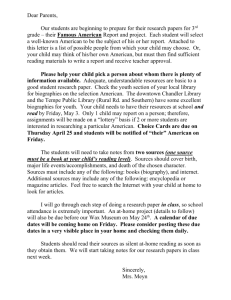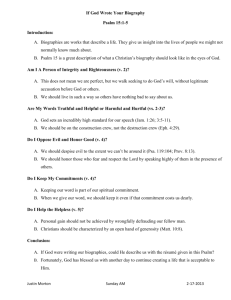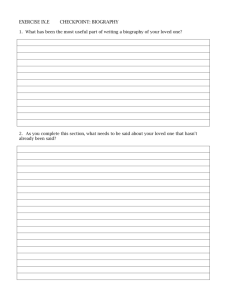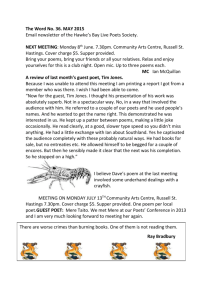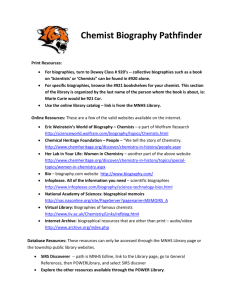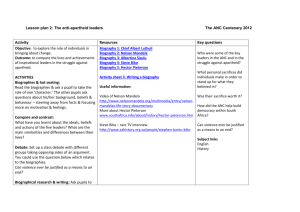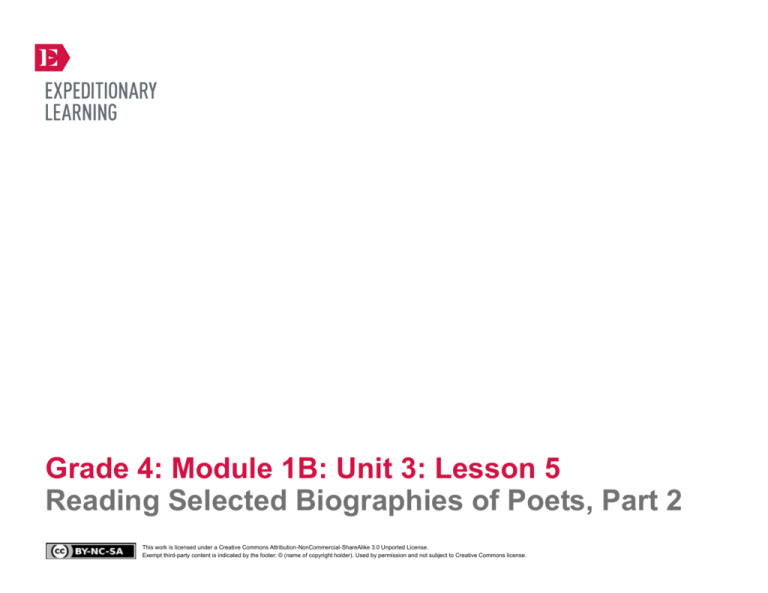
Grade 4: Module 1B: Unit 3: Lesson 5
Reading Selected Biographies of Poets, Part 2
This work is licensed under a Creative Commons Attribution-NonCommercial-ShareAlike 3.0 Unported License.
Exempt third-party content is indicated by the footer: © (name of copyright holder). Used by permission and not subject to Creative Commons license.
GRADE 4: MODULE 1B: UNIT 3: LESSON 5
Reading Selected Biographies of Poets, Part 2
Long-Term Targets Addressed (Based on NYSP12 ELA CCLS)
I can determine the main idea using specific details from the text. (RI.4.2)
I can summarize informational or persuasive text. (RI.4.2)
I can explain the main points in a historical, scientific, or technical text, using specific details in the text. (RI.4.3)
Supporting Learning Targets
Ongoing Assessment
• I can identify important events and ideas about the life of my poet.
• Homework: Further Questions (from Lesson 4)
• I can identify words specific to poetry and biographies about poets )in my selected poet’s biography).
• Important Events and Information note-catcher
Copyright © 2013 by Expeditionary Learning, New York, NY. All Rights Reserved.
NYS Common Core ELA Curriculum • G4:M1B:U3:L5 • June 2014 •
1
GRADE 4: MODULE 1B: UNIT 3: LESSON 5
Reading Selected Biographies of Poets, Part 2
Agenda
Teaching Notes
1. Opening
• In this lesson, students continue building expertise about their selected poet. They identify the most
important events and information in their poet’s biography. Because this can be a complex thing for
students, it is first modeled with Paragraphs 1 and 2 of the William Carlos Williams text. Emphasize to
students that they are to look for and identify key events rather than additional details.
A. Engaging the Reader: Building Knowledge through
Reading (10 minutes)
B. Reviewing Learning Targets (5 minutes)
2. Work Time
A. Identifying Important Events and Information (25
minutes)
B. Adding to the Word Wall (15 minutes)
3. Closing and Assessment
A. Fact Share: Mix and Mingle (5 minutes)
4. Homework
A. Continue reading your independent reading book.
• Students also add words relating to poetry and biographies about poets to the Word Wall. These words
are selected by students from the texts they read, but teachers should guide students in determining
which words go on the Word Wall. Review the vocabulary listed in the Lesson Vocabulary section of this
lesson and help students select words for the Word Wall using the following criteria: 1) The word is
particular to poetry 2) the word is likely to be encountered in reading biographies of poets.
• Lesson 6 includes the mid-unit assessment. In Lesson 4, you collected students’ work, so now be
prepared to provide feedback and guidance to those students who struggled with using evidence to
answer questions either with inferring from details in the text or with finding the main idea.
• In advance:
– Read the biographies and determine which information/events you would identify as the most
important so you are prepared to ask probing questions to guide to students.
– Post: Learning targets.
Copyright © 2013 by Expeditionary Learning, New York, NY. All Rights Reserved.
NYS Common Core ELA Curriculum • G4:M1B:U3:L5 • June 2014 •
2
GRADE 4: MODULE 1B: UNIT 3: LESSON 5
Reading Selected Biographies of Poets, Part 2
Lesson Vocabulary
Materials
Robert Frost: renowned, successful,
inspired, graduated, traditional,
meters, rhyme, free verse, style,
publisher, career
• William Carlos Williams anchor chart (begun in Lesson 1)
• Word Wall (begun in Lesson 3)
• Author’s Note: A River of Words (from Lesson 2; one per student)
• Important Events and Information note-catcher (one per student and one to display)
Valerie Worth: free verse, celebrated,
author, collaboration, illustrated
Walter Dean Myers: renowned, rhyme,
rhythm, language
• Biographies of selected poets (from Lesson 4; one of their selected poet per student):
– “Robert Frost (March 26, 1874 – January 29, 1963)” (one per student in Robert Frost group(s))
– “Valerie Worth (October 29, 1933 – July 31, 1994)” (one per student in Valerie Worth group(s))
– “Finding Your Voice” (one per student in Walter Dean Myers group(s))
• Highlighters (one per student)
• Index cards (for adding words to word wall; about 15)
Opening
Meeting Students’ Needs
A. Engaging the Reader: Building Knowledge through Reading (10 minutes)
• Invite students to sit together in their poet groups.
• Reviewing homework in the lesson
holds students accountable. It can
also highlight who isn’t doing
homework regularly in order to
open dialogue about the importance
of doing homework in relation to
work in the lesson, and how to
ensure homework is completed.
• Remind them that in the previous lesson, they read a biography of their selected poet. Ask students to discuss in groups:
* “How did reading and answering questions about the biography help you build knowledge about the life of your poet?”
• Select volunteers to share their responses. Listen for students to explain that the biography contained important facts and
information that helped them build knowledge and an understanding of the life of their selected poet. Answering questions
about the biography encouraged them to read the text more closely in order to gain a greater understanding of the important
life events of the poet, particularly in relation to his or her writing.
• Invite students to refer to the questions they should have recorded on their Homework: Further Questions (from Lesson 4)
to share those questions with their group.
• Explain that the biographies of poets are brief and only outline the main events of their poet’s life, but when you begin to
learn about something or someone, it often raises questions that make you want to dig deeper and learn more. Emphasize
that later in the unit, students will be exploring more resources to learn more about their selected poet, so some of their
questions may be answered then.
Copyright © 2013 by Expeditionary Learning, New York, NY. All Rights Reserved.
NYS Common Core ELA Curriculum • G4:M1B:U3:L5 • June 2014 •
3
GRADE 4: MODULE 1B: UNIT 3: LESSON 5
Reading Selected Biographies of Poets, Part 2
Opening (continued)
Meeting Students’ Needs
B. Reviewing Learning Targets (5 minutes)
• Focus students’ attention on the learning targets:
• To provide additional support for
students, give them an example
before asking them to discuss this
prompt with a partner. Example: “I
think I will see the word ‘publish’ in
my poet’s biography, because we
read his published poems in Love
That Dog.”
* “I can identify important events and ideas about the life of my poet.”
* “I can identify words specific to poetry and biographies about poets (in my selected poet’s biography).”
• Invite students to read the first learning target with you. Focus students’ attention on the William Carlos Williams
anchor chart and remind them that in the first three lessons of the unit, they practiced collecting important facts about the
life and poetry of William Carlos Williams on the anchor chart. Explain that now they will gather important facts about the
life of their poet.
• Invite students to read the second learning target with you. Draw students attention to the Word Wall and ask students to
discuss with their group:
* “Which words from our Word Wall do you think you may see in the biography of your poet, and why?”
• Cold call students to share their responses. Tell students that they will be adding to the Word Wall today because they will
focus on words related to poetry and biographies about poets in the biographies they began reading during Lesson 4.
Copyright © 2013 by Expeditionary Learning, New York, NY. All Rights Reserved.
• For ELL students, consider
providing additional support with
the following sentence frame: “I
think I will see the word _______
because _________.”
NYS Common Core ELA Curriculum • G4:M1B:U3:L5 • June 2014 •
4
GRADE 4: MODULE 1B: UNIT 3: LESSON 5
Reading Selected Biographies of Poets, Part 2
Work Time
Meeting Students’ Needs
A. Identifying Important Events and Information (25 minutes)
• Explain that students will now identify the information and events in their poet’s biography that are the most important.
• Consider allowing struggling writers
to record the key information on
their note-catcher for a smaller
number of paragraphs. As long as
they have the information
underlined on their biographies,
they can refer to this later on when
they write.
• Explain that they are to imagine they have only 30 seconds to tell someone who doesn’t know anything about their poet the
most important things to give them a good idea of what happened in his or her life.
• Model this, with the help of the class, with the Author’s Note: A River of Words. Display a copy and invite students to
retrieve their copies of the Author’s Note to help you.
• Reread the first paragraph aloud and invite students to read silently in their heads. Ask students to discuss in groups:
* “What do you think is the most important information in this paragraph? If you only had a short time to tell someone
about William Carlos Williams, which information in this paragraph would you pick out to share? Why?”
• Select volunteers to share their responses. Listen for students to identify the following:
– He was a family doctor in New Jersey for more than 40 years.
– During the Great Depression, when people couldn’t afford to pay him, he helped them anyway.
• Listen for students to explain that this information is the most important to pick out because it explains what he did for a job
and what he was like as a person. The other information in the paragraph includes less important details about how he did
his job.
• Underline that important information on the displayed Author’s Note.
• Repeat with the next paragraph. Listen for students to identify the following: 1) he always made time for poetry, 2) he
developed his own distinctive style in which he used shorter lines, brief stanzas, and little or no punctuation, and 3) he
focused on everyday objects. Again, that information explains what anyone would need to know about his poetry, while the
other information includes less important details.
• Display and distribute the Important Events and Information note-catcher. Model collecting those underlined facts
on the organizer.
• Invite students to retrieve their biographies of selected poets from the previous lesson.
• Explain that they are now going to work as a group to identify the most important information in their poets’ biographies.
• Read the directions at the top of the Important Events and Information note-catcher aloud and invite students to read along
silently in their heads.
Copyright © 2013 by Expeditionary Learning, New York, NY. All Rights Reserved.
NYS Common Core ELA Curriculum • G4:M1B:U3:L5 • June 2014 •
5
GRADE 4: MODULE 1B: UNIT 3: LESSON 5
Reading Selected Biographies of Poets, Part 2
Meeting Students’ Needs
Work Time (continued)
• Invite students to begin.
• Circulate to provide feedback and guidance to those students who may need more support (based on the work you collected
in Lesson 4).
B. Adding to the Word Wall (15 minutes)
• Remind students that in this unit they are reading biographies of poets and collecting words about poetry and poets on the
Word Wall about these biographies.
• Distribute highlighters.
• Encouraging students to discuss
before highlighting words can help
to ensure all students understand
why those words meet the criteria.
• Invite students to work in groups, reading one paragraph of their poets’ biographies at a time to discuss and highlight
vocabulary:
* “Which of the words are we likely to see again in a biography of a poet?”
• Circulate to support groups as they work. Students may find it challenging to identify vocabulary particular to their poet’s
biography (world-renowned, traditional, style, illustrated, language) or words related to poetry in general, so ask guiding
questions:
* “What makes that a word particular to biographies of poets?”
* “Is it about poetry or poets?”
* “Is it a biography word? Might I see this word in another biography? Why?”
* “What does it mean?”
• Refocus whole group. Invite groups to share out the vocabulary they have highlighted. If a highlighted word is not likely to
be found in another poet’s biography, guide students to understand this.
• Record appropriate new poetry and biography words and student-friendly definitions on the Word Wall.
– From the Robert Frost biography, listen for words such as: renowned, successful, inspired, graduated, traditional,
meters, rhyme, free verse, style, publisher, and career.
– From the Valerie Worth biography, listen for: free verse, celebrated, author, collaboration, and illustrated.
– From the Walter Dean Myers biography, listen for: renowned, rhyme, rhythm, and language.
Copyright © 2013 by Expeditionary Learning, New York, NY. All Rights Reserved.
NYS Common Core ELA Curriculum • G4:M1B:U3:L5 • June 2014 •
6
GRADE 4: MODULE 1B: UNIT 3: LESSON 5
Reading Selected Biographies of Poets, Part 2
Meeting Students’ Needs
Closing and Assessment
A. Fact Share: Mix and Mingle (5 minutes)
• Follow the directions for this Mix and Mingle activity:
– Invite students to choose one piece of information they recorded about their poet on their Important Events and
Information note-catcher.
– Play music and invite students to circulate around the room.
– Stop the music after 30 seconds.
– Invite students to share their information with the student standing closest to them.
– Repeat until students have shared information with three or four students.
Homework
Meeting Students’ Needs
• Continue reading your independent reading book.
Copyright © 2013 by Expeditionary Learning, New York, NY. All Rights Reserved.
NYS Common Core ELA Curriculum • G4:M1B:U3:L5 • June 2014 •
7
Grade 4: Module 1B: Unit 3: Lesson 5
Supporting Materials
This work is licensed under a Creative Commons Attribution-NonCommercial-ShareAlike 3.0 Unported License.
Exempt third-party content is indicated by the footer: © (name of copyright holder). Used by permission and not subject to Creative Commons license.
GRADE 4: MODULE 1B: UNIT 3: LESSON 5
Important Events and Information Note-catcher
Name:
Date:
Directions:
1. Read the first paragraph of your poet’s biography as a group.
2. Discuss with your group which information you think is the most important and why.
3. When you all agree on what the most important information is, underline it on your biography.
4. Repeat with the next paragraphs, until you have worked your way through the whole biography.
5. Record the important events and information that you have underlined on the note-catcher below.
Important Events and Information
Copyright © 2013 by Expeditionary Learning, New York, NY. All Rights Reserved.
NYS Common Core ELA Curriculum • G4:M1B:U3:L5 • June 2014 •
9
GRADE 4: MODULE 1B: UNIT 3: LESSON 5
Important Events and Information Note-catcher
Important Events and Information
Copyright © 2013 by Expeditionary Learning, New York, NY. All Rights Reserved.
NYS Common Core ELA Curriculum • G4:M1B:U3:L5 • June 2014 •
10

